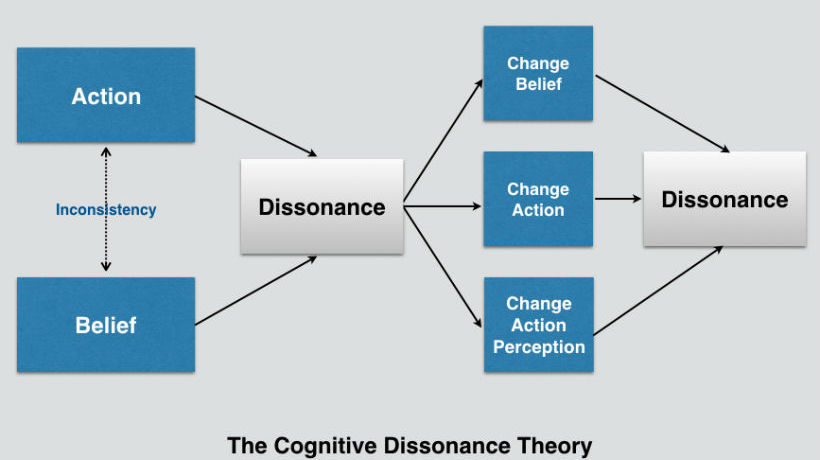Let’s start with a definition:
Cognitive Dissonance: the state of having inconsistent thoughts, beliefs, or attitudes, especially as relating to behavioral decisions and attitude change.
Oxford English Dictionary
Cognitive Dissonance is a very uncomfortable feeling. It hurts. It can cause a mental breakdown. It can shorten your life because of the stress it causes. But it can also be a force for good.
Another word for cognitive dissonance is shame. It happens when you don’t act like the person you are. It’s feels painful because you are literally harming yourself. To fix it, you need to lean into guilt, but don’t stay stuck in regret. Let me explain:
Guilt is when you realize that you have done something wrong.
Regret is when you don’t do anything about it.
Shame is the act of continuing to feel guilt and regret.
shame = guilt + regretGuilt is good. Everyone feels guilt. If you don’t feel guilt, something is wrong with you. You are a sociopath. You should be put in prison or become a lawyer.
Shame is not good. Shame is the combination of guilt and regret. You need to recognize the guilt and really see how what you did was shitty. You also have to acknowledge that you actually feel guilty and it gives you regret. But then, your job is to figure out what you need to make the guilt stay and the regret go. Once you do this, the shame – and thus the cognitive dissonance – will fade.
Your goal should be to increase guilt, and decrease shame. That’s it! That’s the meaning of life! The rest of this post is just filler.
The goal of life is to increase guilt and decrease shame.
Psychology tells us that there are only 3 ways to get rid of cognitive dissonance, and therefore remove shame:
- Change what you believe
- Change what you do
- Justify what you do by reframing it to match what you believe

In most cases, #3 is the easiest but least helpful thing to do. We do this all the time subconsciously. The problem is that it usually leads to more cognitive dissonance down the road and turns you into an asshole. #2 is really hard because it goes against your nature. #1 is usually the right thing to do.
But changing what you believe is the thing you are trying to avoid. This is because it means you have to re-adjust your reality and question the very notion of who you are. This is really hard because what you believe makes you who you are. It gives your life meaning. You’ve built a story of your life over your entire lifetime brick by brick, one belief at a time stacked on top of each other. It gives you your place in society. Is the very fabric of your existence.
The problem is, though you built a really nice building, unless you paid attention to its structural integrity, it’s going to fall in an earthquake. And the more cognitive dissonance is build into it, the more damage that earthquake is going to do.
Here’s a couple of ways you build cognitive dissonance:
Anger. Whenever you are angry, it is because you are feeling the pain of cognitive dissonance. Anger should be a clue that something you believe is not matching up with what you are doing. It will feel like someone else doing something to you – and maybe that’s part of it – but it happens because the reality you are in does not match how you think the world should be.
Drugs. One of the great things about drinking or using drugs, is that it dulls your senses (or increases them). But this distracts you from focusing on the cognitive dissonance. In effect, you are doing #3 – justifying your actions by ignoring them or postponing thinking about them. But it quickly becomes a cycle.
You are in pain because your values don’t match your reality, so you avoid this pain by getting high. Then you don’t deal with it so you do more things that are in conflict with your values, and the cognitive dissonance piles on. Then, more dissonance means more pain, and you need a bigger distraction, so you need to get higher the second time. And the cycle continues.
So the first thing to do when you feel the pain of regret (sometimes exhibited as anger), is to sit down and reframe it as Cognitive Dissonance. Next, step back and cooly decide if you need to change your actions or your belief.
Then, if you are brave enough, change.
